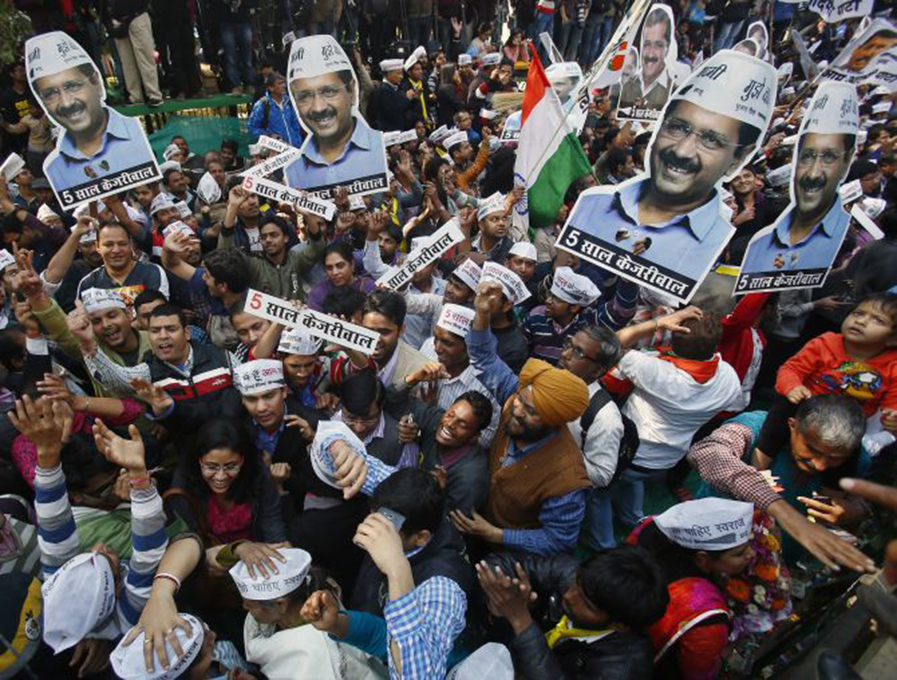New windows of hope have reopened and the fissures in the behemoth, till now backed by the media and corporates, seem to be cracking. A wave of relief has swept India, writes Amit Sengupta from Delhi…
Ahankaar Ishwar ka bhojan hota hain, (Arrogance is the food of God). Not so surprisingly, days before the polls, even the BJP workers in Delhi, many of them on record, were declaring this uncanny prophecy loaded with bitter realism. If the wave was an undercurrent, and if the one-dimensional and arrogant twosome of Narendra Modi-Amit Shah refused to see it, it was truly, a case of sinking sinking drinking water. This water has turned out to be saline; and, indeed, these electoral waters might mark the turning point quagmire in the we-are-the-two-bullies-and-we-care-a-damn-road-roller that seemed to be crushing the entire country into a prolonged spell of suffocation, helplessness and despair.
Post the Lok-Sabha elections, that this has happened in just about eight months, has marked an unprecedented relief and historic shift in the political subconscious of the entire nation. Not only the social media, or, the crawling channels and newspapers which had completely succumbed to the prophet-worship of Modi day-in, day-out, across social and community spaces, on the streets and public squares, inside private spaces and homes, even inside long-distance trains, a wave of relief and jubilation has come to flow marking a stunning departure from the relentless xenophobic muscle-flexing and the 56-inch crass body language and crude megalomania on full display day after day. New windows of hope have reopened and the fissures in the so-called invisible behemoth, till now backed by most of the media and salivating corporates, seem to be cracking.
Truly, the cracks have started with the Delhi tsunami which has decimated both the BJP and Congress in one decisive paradigm shift marking the truth that wherever and whenever there is a plausible and decent alternative, people would reject the communal forces who camouflaged their ideology in the name of development and a fake ‘Gujarat model’, but quickly chose to unleash it moments after they captured power in Delhi, and, then, in state after state, especially riding on the anger and disgust against the discredited and corrupt Congress regime with an uncommitted son of a dynasty who will always remain a disinterested little boy lost in the woods.
With the basic BJP vote share intact, that the people of Delhi across the class spectrum would vote like an enraged angry collective, decimating the one-man megalomania of a narcissist Modi and his best buddy Amit Shah, whose body-language does not really assure us of an iota of statesmanship either, seems magical in the first instance. However, clearly, people saw through the Rs. 10 lakh suit with his name inscribed all over it and found it utterly repulsive; this is a folk narrative now in every gully and mohalla. Also, the manner in which the Prime Minister, in his unabashed self love, chose to change clothes many times in a day in a fancy dress kind of competition, wearing garish combinations which even teenagers would find distasteful. Besides, who pays for all these clothes?
Besides, personal attacks on Arvind Kejriwal, calling him Naxalite, Anarchist, badnasib etc, caricaturing his children in huge ads, the many crores spent on front-page, back-page ads in every newspaper and across thousands of hoardings across the capital with Modi splashed all over like a rock-star and messiah, made people sick. Kiran Bedi, an opportunist who found Modi’s face as the “most beautiful one”, arrived like an inevitable disaster. So much so that when she lost her voice, it came as a moment of relief. That she too lost the elections has come as a bigger relief. Perhaps, even for those BJP workers who worked on the ground to defeat her and other stalwarts who found the ground beneath their feet slipping much before the polls.
The repeated attacks on churches, the retrograde ghar wapasi campaign, the glorification of Nathuram Godse, the proclamation that all women should have four children, the tirade against girls wearing jeans, the bad taste of Raamzaades versus Haraamzaades, the forcible injection of Sanskrit and saffronisation of education, the indecent manner in which the Censor Board chief and others were compelled to quit, and the daily dose of Ku Klux Klan kind of morbid, racist and regressive discourse, was universally hated by Delhiites, especially the young. Now, really, you can’t force everybody to drink cow urine, nor can you force the educated to believe that we were flying planes and exploding nuclear bombs thousands of years ago.
All the pomp and show of showcasing himself as a rock star, in Madison Square in New York with miscellaneous and stinking rich Gujarati NRIs swinging, or swinging in a jhula at Ahemedabad with the Chinese premier even while Chinese forces entered the LoC, made no real sense to the people of India, especially the poor. The rhetoric seems to have become a horror movie with Ramsay Brothers proportions, often turning into a comical caricature, with no real work on the ground. So, what happened to all the promises? Clean Ganga and clean all the rivers campaign? Toilets for all? Bullet trains? Smart cities? Jobs for all? Return of black money with Rs. 15 lakh deposited in every account? Overnight prosperity and vikas? Swachh Bharat?
Almost all his feku promises seem to be hanging in a schizophrenic theatre of the absurd, as fake as the half-promises and claims of the ‘Gujarat model’ which the media and voters bought lock, stock and barrel during the manufactured consent that was the Lok Sabha electoral campaign with Modi eternally ‘live’ on TV with no ad-break. You can spend many thousand crores, hire the top-most PR companies and event managers, get all the corporates and their upwardly mobile parasites to pump you up even as you promise to subsidise them, but you can fool the people only for some time, not all the time. Delhi, the microcosm of a pluralist, diverse India, has proved precisely that.
The middle class, the educated young, the small traders and shop-keepers, government employees, women, the minorities, the people from the North-east, the huge Bihari population in Delhi and tens of thousands of migrants from other states, almost the entire scaffolding of the poor and the poorest of the poor, have voted for the AAP, and against the overtly rich man’s party, that is, the BJP. This has been a remarkable U-turn and paradigm shift in Indian politics and will mark the advent of a completely new kind of middle stream of politics which is neither Left, nor extremist, nor discredited and corrupt as the Congress with its discredited dynasty, and nor pro-corporate and fascist like the hydra-headed xenophobic organism called the Sangh Parivar with its lunatic fringe and the mainstream operating in tandem.
India is not a Hindu Rashtra, howsoever the RSS and VHP leaders can scream 24×7, thereby denigrating the basic essence of the Indian Constitution. You can’t drop secular and socialist from the Preamble as and when you wish and get away with it. India is a secular, pluralist, democratic nation. And as long as the vast multitudes of hard working and labouring people of this country, as in the thousands of slums and make-shift inner-ghettos of Delhi, survive their existential daily lives in abject poverty, degradation and humiliation, in sub-human conditions with sewage drains literally running through their homes, just about surviving on less than Rs. 5,000-7,000 per month, India will have to redefine and sustain the socialist path, perhaps with a new perspective.
The people of India want real change. The poor people of India want radical social transformation. The country does not only belong to a handful of upwardly mobile rich, cold-blooded in their selfish pursuits. False promises and fake models will not work anymore. And if you are vulgar, crass, arrogant and megalomaniac, people will punish you. As they did in Delhi.


